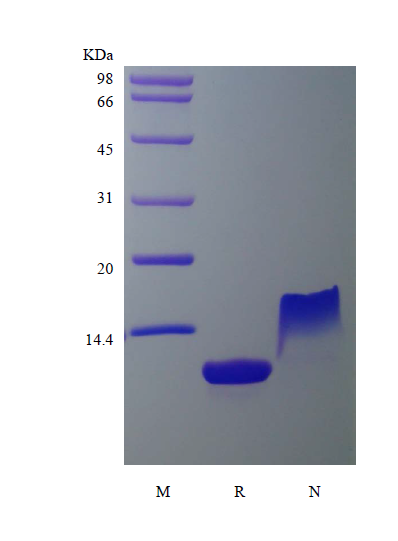- Synonyms
-
- Source
- Escherichia coli.
- Molecular Weight
- Approximately 7.9 kDa, a single non-glycosylated polypeptide chain containing 70 amino acids.
- AA Sequence
- ARATNVGREC CLDYFKGAIP IRKLVSWYKT SVECSRDAIV FLTVQGKLIC ADPKDKHVKK AIRLVKNPRP
- Purity
- > 97 % by SDS-PAGE and HPLC analyses.
- Biological Activity
- Fully biologically active when compared to standard. The biologically active determined by a chemotaxis bioassay using human T-lymphocytes is in a concentration range of 1.0-10 ng/ml.
- Physical Appearance
- Sterile Filtered White lyophilized (freeze-dried) powder.
- Formulation
- Lyophilized from a 0.2 µm filtered concentrated solution in PBS, pH 7.4.
- Endotoxin
- Less than 1 EU/µg of rMuTARC/CCL17 as determined by LAL method.
- Reconstitution
- We recommend that this vial be briefly centrifuged prior to opening to bring the contents to the bottom. Reconstitute in sterile distilled water or aqueous buffer containing 0.1 % BSA to a concentration of 0.1-1.0 mg/ml. Stock solutions should be apportioned into working aliquots and stored at ≤ -20 °C. Further dilutions should be made in appropriate buffered solutions.
- Stability & Storage
- Use a manual defrost freezer and avoid repeated freeze-thaw cycles.
- 12 months from date of receipt, -20 to -70 °C as supplied.
- 1 month, 2 to 8 °C under sterile conditions after reconstitution.
- 3 months, -20 to -70 °C under sterile conditions after reconstitution.
- Usage
- This material is offered by Shanghai PrimeGene Bio-Tech for research, laboratory or further evaluation purposes. NOT FOR HUMAN USE.
- SDS-PAGE

- Reference
- 1. Loftus BJ, Kim UJ, Sneddon VP, et al. 1999. Genomics, 60: 295-308.
2. Imai T, Baba M, Nishimura M, et al. 1997. J Biol Chem, 272: 15036-42.
3. Imai T, Yoshida T, Baba M, et al. 1996. J Biol Chem, 271: 21514-21.
4. Jakubzick C, Wen H, Matsukawa A, et al. 2004. Am J Pathol, 165: 1211-21.
5. Shimada Y, Takehara K, Sato S. 2004. J Dermatol Sci, 34: 201-8.
6. Sumiyoshi K, Nakao A, Setoguchi Y, et al. 2003. J Dermatol Sci, 31: 53-8.
- Background
- Murine CCL17 also known as TARC, Small-inducible cytokine A17, Thymus and activation-regulated chemokine and SCYA17, is encoded by the CCL17 gene located on the chromosome 8. Among CC chemokine family members, CCL17 has approximately 24 – 29 % amino acid sequence identity with RANTES, MIP-1α, MIP-1β, MCP-1, MCP-2, MCP-3 and I-309. CCL17 is a secreted protein and expressed by thymus cells constitutively and phytohemagglutinin-stimulated peripheral blood mononuclear cells transiently. It signals through the chemokine receptors CCR4 and CCR8 and displays chemotactic activity for T lymphocytes and some other leukocytes. CCL17 play an important role in skin diseases such as atopic dermatitis, bullous pemphigoid and mycosis fungoides.
Recombinant CCL17 has been shown to be chemotactic for T cell lines but not monocytes or neutrophils.









 COA Application
COA Application


